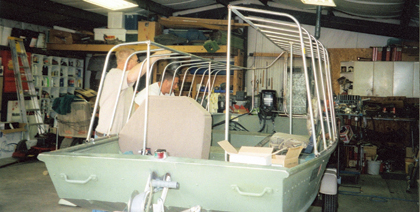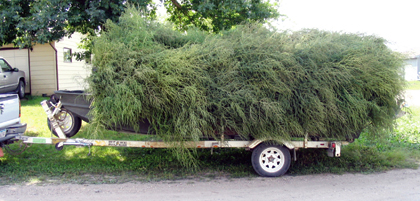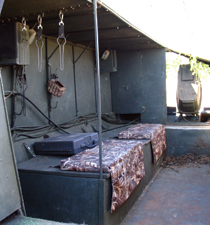November 03, 2010
By Mike Marsh
Plus two more ducky designs from a couple of hardcore 'fowlers.
By Mike Marsh
 Scott Uehling's Waterfowler's Boat Blind has a frame of electrical conduit, which is bent and welded into shape. |
Scott Uehling of North Platte, Nebraska designed and built a boat blind during a six-week period of time during the summer and fall of 2006. The blind is built onto a 16-foot aluminum johnboat, which is powered by a 25 hp Mercury outboard motor. He calls it the "Waterfowler's Boat Blind" and the blind is approximately 14 feet in length and five feet in width, with a two-foot long platform across the bow of the boat. The platform is used for decoy storage as well as for a place for a retriever to sit during a hunt.
The exterior frame is constructed of 1⁄2-inch electrical conduit, which is welded together using a 110-volt arc welder. The frame on the right side of the boat is approximately eights inches lower than the left side. The higher left side allows hunters ample room to sit beneath it, protecting them from the elements and from being spotted by waterfowl looking over the decoys from behind the hunters. The conduit frame is painted with a flat green aerosol paint to prevent the glare of reflected sunlight from potentially alerting incoming waterfowl. The lower elevation of the right side provides easy viewing for hunters when ducks and geese are decoying low to the water.
Advertisement
The outer shell of the blind is made from a vinyl tarp material and it was cut and sewn together by an upholstery shop. The shell was equipped with grommets around the perimeter that allow the shell to be fastened to the frame by using zip ties.
Nylon netting was attached to the outside of the vinyl shell by the use of zip ties. The netting provides a thin layer of material into which grass and tumbleweeds can be inserted or attached with zip ties or string.
Advertisement
The shooting port has eight separate flaps connected by zippers. There are a total of four hunter positions so each hunter has two shooting port options.
The blind has two doors. One door is positioned in the middle of the bow. The other door is positioned in the back of the boat at the left side of the motor. The doors are large enough for hunters to enter and exit easily while dressed in waterfowl hunting clothing and carrying their gear.
 The Quaker Wacker: hunt-ready. |
Four swivel seats are positioned on the left side of the boat, but they are placed rearward enough to leave adequate space near the bow for the dog to sit. Two catalytic heaters, one at each end, provide warmth for the hunters. There is also a single-burner stove in the middle of the boat for cooking and for providing additional heating when it is needed.
Battery-powered lights are placed throughout the interior of the blind, providing enough light for hunters to ready their equipment in the darkness before a hunt begins.
"This boat and blind has been tested and used on several occasions over the past hunting season," Uehling said. "So far, the blind has stood up to all of the elements. I am anticipating many years of enjoyment from the blind I built with help from my dad."
Dean's Quacker Whacker
Cory Dean of Spirit Lake, Iowa built a boat blind he calls the "Quacker Whacker" on a base consisting of a 17-foot Polar Craft boat powered by an 85 hp Yamaha motor.
"I didn't build the boat, but I've tweaked it to be the way I envisioned it," Dean said. "It never seems to be finished and I'm always coming up with new ways of preparing it for each season. The boat is really a part of the family in a weird way and of course, when the season starts, it has its own parking spot and is ready to go at the sound of a duck call."
The blind is made of 1⁄2-inch square tubing, which is covered by .80-gauge aluminum sheeting. Web wire (two- by four-inch dog kennel wire) fencing was added over the outside of the aluminum walls for the purpose of attaching tumbleweeds or other vegetation to provide camouflage.
The blind has forward covers that that flip open. When they are closed, they conceal hunters completely, angling from the low front and leaning against the top. The covers are merely sections of wire fencing covered with grass mats and vegetation.
A bench runs beneath the higher side of the blind with the flip covers in front of the hunters offering complete concealment when closed. The bench is used for sitting and as a storage area for PFDs, tools and other necessities. All of the decoys are stowed in bags set around the blind.
Steering is done from a steering console set in the front of the boat for visibility purposes. There would be no way to see out of any other spot in the boat.
 The inside of the Quaker Wacker. |
The bind has four heaters, with three inside the blind and one under the front deck at the bow to keep ice from forming on the metal deck and to keep the dog warm in his hunting position when he is sitting on top of the bow. There is also a cooking stove with three burners, an XM satellite radio and a CD player. The boat is also wired to operate a Mallard Machine and some other electric wobble-type decoys.
Dean said the boat handles as well in shallow water as it does in deep water. Four hunters can sit comfortable on the bench seat and the dog can remain outside of the blind, after gaining access to the bow via a door in the blind wall at the center of the bow. Keeping the dog on the bow keeps water out of the blind after a retrieve has been completed.
Tumbleweeds are attached to the wire fencing on the sides of the boat and artificial grass or grass mats are used on the front of the boat and on the flip covers. If attached to the front of the boat blind, tumbleweeds can be stripped while the boat is being trailered to the hunting site.
 Rich Hill, Poor Man's Blind PVC frame is bent inward by using a heat gun to close the top opening to one-half the width of the boat. |
Beginning at the top of the pilot's hatch, there is a series of white lights that run rearward through the boat. There is also a series of red lights that can be used for illumination instead of the bright lights while preventing the loss of the hunters' night vision. Two batteries are used to provide electrical power, with one battery hooked up to the lights and the other to the motor. Having separate batteries ensures there will be adequate power to start the boat after using the lights and other ancillary equipment for extended periods of time.
Dean uses his Quacker Whacker for hunting sloughs and lakes in Northwest Iowa and has also hunted from the boat blind along the Mississippi and Missouri rivers. More images of the Quacker Whacker can bee seen at www.myspace.com/teamquackerwhacker.
Pilcher's Poor Man's Boat Blind
Tom Pilcher Jr. of Rich Hill, Missouri built a blind for a 14-foot, V-hull aluminum boat with a minimum of weight. He hunts flooded cornfields with the boat blind. The boat blind, despite Tom's address, was built with a minimum of cost, yet looks as good as most other, more elaborate boat blinds.
"This is what happens when the poorest duck hunter in Missouri needs a boat blind," Pilcher said. "The blind has worked well for two seasons and has kept us hidden in a variety of cover."
The base of the blind is formed by 21⁄4- by 21⁄4- by 1⁄4-inch metal angle with three-inch long sections of one-inch diameter pipe bolted to it and along the inside of the boat. The one-inch pipe sections act as sockets to hold 3⁄4-inch conduit uprights used for the blind frame.
The 3⁄4-inch cross pieces along the top and bottom of the blind are held in place with 3⁄4-inch PVC tees placed at the top and bottom of the uprights. All the joints are glued. The uprights are bent inward at the top with the use of a heat gun after the glue joints have had time to cure. The bending is just enough to make the tips of the grass camouflage angle together at the top, leaving an opening approximately half the width of the boat.
Uehling's Waterfowler's
Boat Blind Material List: |
|---|
| 1/2-inch Electrical Conduit | $80.00 |
|---|
| Vinyl Tarp Shell | $130.00 |
|---|
| Nylon Netting | $30.00 |
|---|
| Zip Ties | $25.00 |
|---|
| Spray Paint (Flat Green) | $20.00 |
|---|
| Interior Lights | $15.00 |
|---|
| Seats | $150.00 |
|---|
| Mr. Heater Heaters (2) | $100.00 |
|---|
| Cooking Stove | $35.00 |
|---|
| TOTAL | $585.00 |
|---|
The back panel of the blind is made from 1⁄2-inch PVC and is a simple rectangular frame made using PVC elbows and tees. At the each outside end an extension allows downward facing PVC stubs to be inserted into upward turned 3⁄4-inch PVC elbows, which extend from the upper ends of the sides panels. This allows the rear panel to be lifted free for easy travel, access and setup.
Since the front of the boat is sharply angled, two front frame sections are used for concealment and access. They are also made of 1⁄2-inch PVC pipe. The rear of the top runner of each forward frame slides into an open 3⁄4-inch PVC end on the forward top runner of the side frames, entering about four inches deep in the manner of a telescope. The bottoms of the front panel corners have 1⁄2-inch PVC stubs facing downward to fit into 1-inch PVC sockets pointing upward at the center of the bow. All that is necessary to remove the front panels or rear panel is to lift them free.
The boat is painted to match the cornstalks, grass and other marsh vegetation. It is also important to paint the white PVC pipe, conduit and fittings.
Instead of using elaborate and expensive materials for the sides of the blind, Pilcher used his head by selecting the simplicity of decoy string. Multiple decoy lines are stretched and tied with a only a few inches separating them in between the blind uprights, with the lines running parallel to the bottom of the boat like the strings of a harp.
Bundles of grass are woven tightly between the taut decoy lines so the grass won't blow off while the boat is being towed. If some bundles do blow off the blind, they are easily replaced with grass or cornstalks once the hunters arrive at their hunting site. Once it is set up at the hunting site, the blind can be further camouflaged by leaning grass or cornstalks against the blind.
